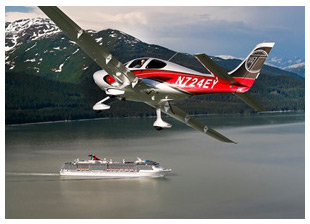Training Tips
|

Running your aircraft's fuel supply down to an extremely low level holds obvious risk. Can you think of a less apparent risk that also arises, especially in uncoordinated flight?
Some aircraft carry a warning against performing slips with flaps extended, because the configuration can interfere with airflow over the horizontal tail. What other hazard enters the slipping scenario when fuel is low?
Low-fuel, uncoordinated-flight profiles run the risk of the remaining fuel supply sloshing away from the lines that carry gas to the engine—a problem known as unporting. Unporting is frequently scrutinized as an accident cause when an aircraft engine fails with some fuel remaining, and when no mechanical damage is found.
Have you ever noticed how an unsecured object in your car slides or rolls to the outside of a turn when you drive a little too fast on that sharply curving highway on-ramp? Then you have some idea of what the fuel in your aircraft's fuel tanks is doing during an uncoordinated flight maneuver.
In one case, all it took was for an aircraft to be in a departure climb with less than the minimum fuel quantity recommended for takeoff for investigators to point out that the manufacturer's fuel-quantity stipulation "is due to the location of the fuel pickups in the tanks on this model aircraft, which would allow unporting and fuel supply interruption with steep attitudes, turning type ground maneuvers during takeoffs, or uncoordinated flight."
Unporting was discussed by a reader who weighed in on an AOPA Pilot Dogfight article on the topic of fuel management techniques. He urged pilots to pay special attention to coordinating control inputs when fuel quantity has been drawn well down, noting, "The fuel follows the ball. If the ball is toward the far end of the tank, so is the fuel. Any time a tank is one-quarter full or less, it is good practice to monitor the turn coordinator to make sure the ball is at least exactly centered."
You are on your way to mastery of required systems knowledge if you can sketch a basic diagram of system components, describe the operating principle, and explain operating limitations. One of those limitations is the pilot, whose flight planning and fuel management can strive for avoiding the unporting risk altogether.
|
|
Flight Training News
|
|
Rotorcraft Rookie
Believe it or not, helicopters do continue to fly after an engine failure—sort of.
Read more...
Share:
 
Embry-Riddle Aeronautical University will be offering a course on unmanned aircraft at a Florida high school that will also include tuition-free college credit, reports the News-Journal. Students at Atlantic High School in Delray Beach will take a course in unmanned aircraft. Meanwhile the local school board is mulling entering a similar agreement for students at Flagler Palm Coast High School in Palm Coast.

Slideshow
Whether in the early morning or late evening, sweltering heat or frigid temperatures, AOPA photographers Mike Fizer and Chris Rose do whatever it takes to snap the perfect shot. Fizer and Rose share their favorite photos from shoots in 2013.
Read more...
Share:
 
Bring your questions and concerns about learning to fly to AOPA's live Facebook chat on Tuesday, Jan. 8, at 3 p.m. Eastern. The guest will be Flight Training contributor Rod Machado, who has been a CFI since 1973 and is the author of Rod Machado's Private Pilot Handbook and Workbook and Rod Machado's Instrument Pilot's Handbook. To join in the chat, visit the Flight Training Facebook page and click the chat icon, or visit here.
Matt Opliger, a graduate student in aerospace engineering and research engineer for Wichita State University's National Institute for Aviation Research, has been named the 2013 Outstanding Student of the Year by the Department of Transportation and the FAA. He will be honored at the Council of University Transportation Centers Awards Ceremony in Washington, D.C., on Jan. 11 for his research project titled, "Development of the Dynamic Mechanical Analyzer Calibration and Testing Procedures," which was conducted for the FAA's Center of Excellence for Composites and Advanced Materials.
Apps of the week
"General" apps that do everything from offering instructor tools to handling documents for TBM aircraft are highlighted this week.
Read more...
Share:
 
|
Scholarships
|
|
Article
Two aviation foundations receive funding, while two youth scholarships are announced.
Read more...
Share:
 
|
Training Resources
|
|
This video answers the question, "As a student pilot, do I have to accept the assigned runway?" The video is part of the Ask ATC series created by the Air Safety Institute and sponsored by the National Air Traffic Controllers Association.
Watch the video...
Share:
 
|
|
Did you know that student pilots who join AOPA are three times more likely to complete their flight training? Membership includes unlimited access to aviation information by phone (800/USA-AOPA, weekdays from 8:30 a.m. to 8 p.m. Eastern time) or from Flight Training Online or AOPA Online. If you're not already a member, join today and get the pilot's edge.
|
Career Pilot
|
|
Abu Dhabi, United Arab Emirates-based airline Etihad Airways is ramping up its recruiting of cabin crew in the United States. The airline will have recruitment days in Chicago, New York City, and Washington, D.C., in 2014. More than 200 U.S. nationals currently work for Etihad, including 66 pilots and 27 cabin crew.
Boeing has announced it will expand its flight and maintenance training operations in Russia by building a new, state-of-the-art training campus. The new facility, scheduled to open in 2015, will be located in the Skolkovo Innovation Center in Moscow. Initial capability will include flight, maintenance, and specialty training. Local maintenance training will be available across the spectrum of Boeing aircraft currently in operation, and flight training capability will include locally based instructors.
|
|
For more aviation career news, see the Flight Training website.
|
Plane Spotter
|

A plane spotter is part historian. Spotting aircraft with certain features or made from certain materials, the knowledgeable observer can assign it a place in aviation's evolution without certain identification of the exact model. Piper's postwar single-engine aircraft were marked by short, high wings, "conventional gear" (meaning tailwheels), and tube-and-fabric construction. From there, it takes a knowing eye to definitively discern the designation. A side-by-side two-seat taildragger of a 1948 vintage is likely a PA-15 Vagabond. The somewhat elongated PA-16 Clipper, featuring a rear seat, came along a year later.
|
Training Products
|
|
Dyer Flight Training Tools has released the newest editions of two books: Ground School Workshop for Private Pilots and Flight Training Workshop for Private Pilots. Both books offer a set of exercises and study questions matched chapter by chapter to the FAA's Pilot's Handbook of Aeronautical Knowledge. Student pilots and flight instructors can use them to prepare for training flights and lessons to be learned in the air. The ground school book costs $32.95; the flight training book costs $27.95.
|
|
Note: Products listed have not been evaluated by ePilot editors unless otherwise noted. AOPA assumes no responsibility for products or services listed or for claims or actions by manufacturers or vendors.
|
Member Benefits
|
|
Members only
A medical condition that brings the FAA down on you can be scary. The last thing you need is more worry.
Read more...
Share:
 
Member benefits
If there are two things Roger Cannell knows a few things about, it's flying and aviation insurance. The former aviation insurance underwriter has been a pilot for more than 50 years and relies on AOPA Insurance Services.
Read more...
Share:
 
|
|
|
Blogs
|
|
In the last two decades, aviation training has seen aircraft used that, well, worked. They haven't been ideal, according to designated pilot examiner Jason Blair. "We have used old airplanes, airplanes that cost a lot, airplanes that are too big, and in some cases aircraft that are too complicated. But we have had to use what we have." What is the perfect trainer? He offers his take.
Read more...
Share:
 
The BK117 is a twin-engine, medium-size helicopter developed jointly by Messerschmitt Bolkow Blohm (MBB) of Germany and Kawasaki of Japan.
Read more...
Share:
 
|
Instrument Tip
|
|
IFR Fix
When it comes to determining who has the most experience, it can depend on the flight operation and the experiences the pilot has encountered in the past, no matter the number of hours on paper. Has IFR flying ever taken you outside your experience level?
Share the lessons...
Share:
 
|
Final Exam
|
Question
Airspeed indicators in FAA-certificated aircraft weighing 12,500 pounds or less and manufactured after 1945 are required to be marked in accordance with a standard color-coded marking system. The upper limit of the green arc on the airspeed indicator represents what speed?
Answer
The upper limit of the green arc represents VNO—the maximum structural cruising speed. Do not exceed this speed except in smooth air. (Source: Pilot's Handbook of Aeronautical Knowledge, Chapter 7.)
|
|
Got a question for our technical services staff? Contact AOPA.
|
Career Opportunities
|
|
AOPA career opportunities
Ever dream of turning your passion for aviation into a career? We're looking for an account manager II, event planner, aviation insurance agent, director of insurance business operations, and Web graphic designer I. To learn more about other AOPA career opportunities,
visit AOPA Online.
|
 |
Education and Seminars
|
Flight Instructor Refresher Courses
Jan 4-5 - Ypsilanti, Mich.; Portland, Ore.; San Jose, Calif.; and San Antonio, Texas
Jan 11-12 - Knoxville, Tenn.; Jackson, Miss.; Seattle, Wash.; and Charlotte, N.C.
Jan 25-26 - Baltimore, Md., and Long Beach, Calif.
Feb 8-9 - Fairfax, Va.; Nashua, N.H.; New Orleans, La.; and Louisville, Ky.
For a complete schedule, see AOPA Online. Can't make it in person? Sign up for the Air Safety Institute's new Online eFIRC.
|
Air Safety Institute Safety Seminars
Jan 13 - Mesa, Ariz.; and Reno, Nev.
Jan 14 -Tucson, Ariz.; and Sacramento, Calif.
Jan 15 - Milpitas, Calif.; and El Paso, Texas
Jan 16 - Albuquerque, N.M.; and Santa Rosa, Calif.
Topics vary—for details and a complete schedule, see AOPA Online.
|
|
|
|
|
|
 |
|
|
ePilot Flight Training Editor:
Benét Wilson
Production Team
Katie Richardson
Lezlie Ramsey
Melissa Whitehouse |
Contributors:
Sarah Deener
Alyssa Miller
Jim Moore
Jill W. Tallman
Warren Morningstar
Alton K. Marsh
Dave Hirschman
Tom Horne
Ian J. Twombly
Dan Namowitz |
|
|
|
|